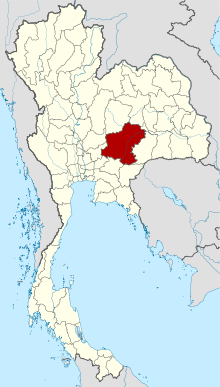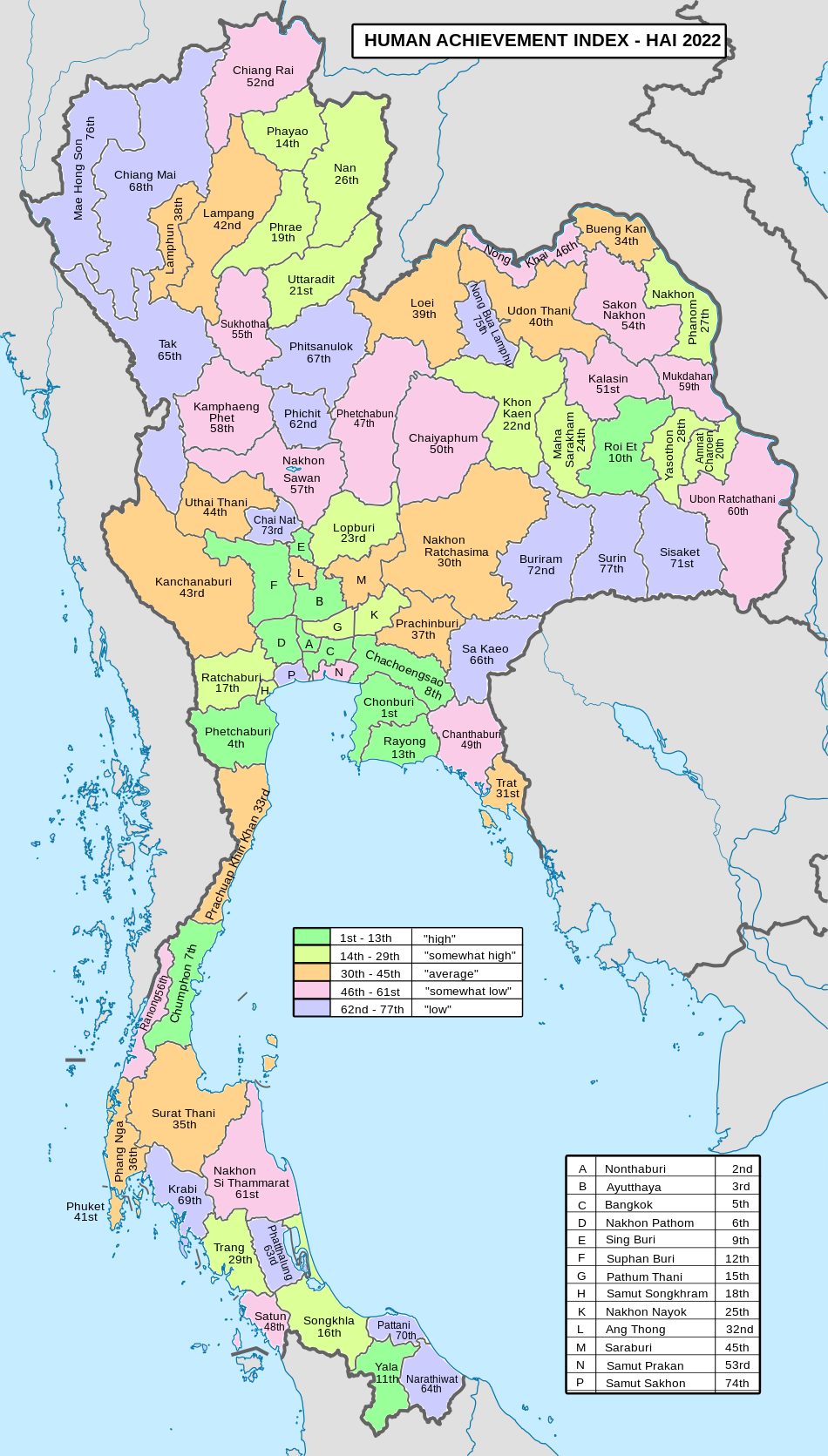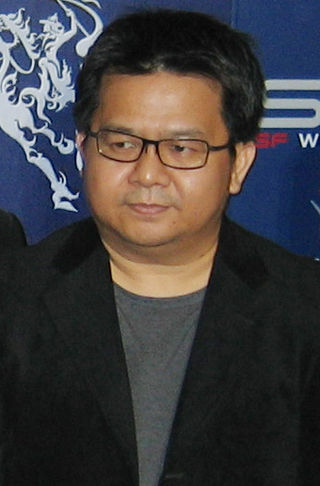Loading AI tools
Province of Thailand From Wikipedia, the free encyclopedia
Nakhon Ratchasima (Thai: นครราชสีมา, pronounced [ná(ʔ).kʰɔ̄ːn râːt.tɕʰā.sǐː.māː]; Northeastern Thai: นครราชสีมา, pronounced [nà(ʔ).kʰɔ᷇ːn lâːt.sā.sǐː.ma᷇ː], often called Khorat (Thai: โคราช, pronounced [kʰōː.râːt]; Northeastern Thai: โคราช, pronounced [kʰo᷇ː.lâːt])) (alternate spelling Korat) is one of Thailand's seventy-six provinces (changwat) lies in lower northeastern Thailand also called Isan. It is the country's largest province by area, has a population of approximately 2.7 million, and generates about 250 billion baht in GDP, the highest in Isan.[6] Neighbouring provinces are (clockwise, from north) Chaiyaphum, Khon Kaen, Buriram, Sa Kaeo, Prachinburi, Nakhon Nayok, Saraburi, and Lopburi.
This article is written like a travel guide. (January 2015) |
Nakhon Ratchasima
นครราชสีมา | |
|---|---|
| Nakhon Ratchasima province | |
(clockwise from upper-left): Phimai Castle, Thao Suranaree Monument, Thai house at Jim Thompson Farm, Chum Phon Gate, Buddha statue at Phanom Wan Castle | |
| Nickname: Korat (Thai: โคราช) | |
| Motto(s): เมืองหญิงกล้า ผ้าไหมดี หมี่โคราช ปราสาทหิน ดินด่านเกวียน ("City of brave women. Excellent silk. Mee Korat. Stone castles. Dan Kwian clay.") | |
 Map of Thailand highlighting Nakhon Ratchasima province | |
| Country | Thailand |
| Capital | Nakhon Ratchasima City |
| Government | |
| • Governor | Siam Sirimongkol (since October 2022)[1] |
| Area | |
| • Total | 20,736 km2 (8,006 sq mi) |
| • Rank | Ranked 1st |
| Population (2022)[3] | |
| • Total | 2,630,058 |
| • Rank | Ranked 2nd |
| • Density | 127/km2 (330/sq mi) |
| • Rank | Ranked 35th |
| Human Achievement Index | |
| • HAI (2022) | 0.6471 "average" Ranked 30th |
| GDP | |
| • Total | baht 275 billion (US$9.5 billion) (2019) |
| Time zone | UTC+7 (ICT) |
| Postal code | 30xxx |
| Calling code | 044 |
| ISO 3166 code | TH-30 |
| Website | www |
The capital of the province is the city of Nakhon Ratchasima in Mueang Nakhon Ratchasima district, also called Khorat.

The province is at the west end of the Khorat Plateau, separated from the Chao Phraya river valley by the Phetchabun and Dong Phaya Yen mountain ranges. Two national parks are in the province: Khao Yai in the west and Thap Lan in the south. Both parks are in the forested mountains of the Sankamphaeng Range, the southern prolongation of the Dong Phaya Yen mountains. The total forest area is 3,193 km2 (1,233 sq mi) or 15.4 percent of provincial area.[2]
Nakhon Ratchasima is a large province on the northeastern plateau and acts as a gateway to other provinces in the northeast. It is 259 kilometres (161 mi) from Bangkok and has an area of around 20,494 square kilometres (7,913 sq mi). The province is rich in Khmer culture and has a long history.
There are two national parks, along with two other national parks, make up region 1 (Prachinburi) of Thailand's protected areas.

The area around Khorat was already an important centre in the times of the Khmer empire in the 11th century, as can be seen by the temple ruins in Phimai historical park. Nakhon Ratchasima province is one of the provinces where there is still a sizable northern Khmer population.[8]
A new walled city with a surrounding moat, designated as Nakhon Ratchasima, was built in the 17th century by order of the King Narai, as the easternmost "command post", guarding the kingdom's border. Nakhon Ratchasima continued this duty during the Bangkok Period, although it was briefly seized during Lao rebellion (1826–1828) in 1826, in the reign of King Rama III of Siam.
Nakhon Ratchasima has long been the most important political and economic centre in the northeastern region. In the late-19th century, the railroad reached Khorat and it became the junction of two main rail lines in the northeastern, Isan, region. In 1933, Nakhon Ratchasima was the stronghold of the royalist troops in the Boworadet Rebellion, as they fought against the new democratic government in Bangkok. In the 1950s, the Korat Royal Thai Air Force Base was built in Nakhon Ratchasima; from 1961 until 26 February 1976, this facility was also used as a base by the United States Air Force.
A mass shooting occurred in the province on 8 and 9 February 2020. The gunman killed 30 and wounded another 57 before being shot dead by police. It was the deadliest mass shooting in Thailand's history.
Nakhon Ratchasima was the birthplace of Thao Suranari who was born in 1771 and was the savior of Nakhon Ratchasima from King Chao Anouvong's army in 1826.

The provincial seal depicts the revered heroine of Khorat, Thao Suranari (Thai: ท้าวสุรนารี).
A monument to Thao Suranari (real name: Khunying Mo; 1771–1852) stands in front of the old Pratu Chumphon gate. Also called "The Great Heroine of Khorat", Kunying Mo was the wife of the Siamese-appointed deputy governor of Nakhon Ratchasima during the reign of King Rama III. In 1826, Khunying Mo managed to repel the Laotian army led by Prince Anouvong of Vientiane who tried to reinstate control over the Khorat plateau. King Rama III conferred the title of Thao Suranari on Khunying Mo, as well as additional ones honouring her bravery.
The provincial tree and flower is the sathon (Millettia leucantha). The provincial aquatic animal is Hoven's carp (Leptobarbus hoevenii).
The provincial motto is "Land of brave women, fine silk material, Khorat rice noodles, Phimai Historical Park, and Dan Kwian ceramics".
The provincial color is orange

The province is divided into 32 districts (amphoes). The districts are further subdivided into 263 sub-districts (tambons) and 3,743 villages (mubans).[citation needed]
NB: On 15 May 2007, the government upgraded all 81 "king amphoes" to "amphoes" to streamline administration.
| Class | Name | Area (km2) | Distance to Provincial Hall (km) | Established | Sub-districts (Units) | Villages (Units) | Population | ||
|---|---|---|---|---|---|---|---|---|---|
| Male | Female | Total | |||||||
| Special | Mueang Nakhon Ratchasima | 755.596 | 0 | 1895 | 25 | 243 | 212,627 | 221,211 | 433,838 |
| 1 | Dan Khun Thot | 1,428.14 | 84 | 1908 | 16 | 220 | 62,571 | 63,347 | 125,918 |
| 1 | Bua Yai | 305.028 | 101 | 1886 | 10 | 121 | 41,855 | 42,278 | 84,133 |
| 1 | Pak Thong Chai | 1,374.32 | 34 | 1910 | 16 | 213 | 56,716 | 58,950 | 115,666 |
| 1 | Phimai | 896.871 | 60 | 1900 | 12 | 208 | 64,421 | 66,024 | 130,445 |
| 1 | Sikhio | 1,247.07 | 45 | 1955 | 12 | 169 | 60,898 | 61,163 | 122,061 |
| 1 | Pak Chong | 1,825.17 | 85 | 1955 | 12 | 217 | 91,146 | 91,685 | 182,831 |
| 2 | Khon Buri | 1,816.85 | 58 | 1939 | 12 | 152 | 46,086 | 47,167 | 93,253 |
| 2 | Chakkarat | 501.672 | 40 | 1953 | 8 | 108 | 34,441 | 34,643 | 69,084 |
| 2 | Chok Chai | 503.917 | 30 | 1905 | 10 | 126 | 37,297 | 39,223 | 76,520 |
| 2 | Non Sung | 676.981 | 37 | 1897 | 16 | 195 | 62,639 | 65,374 | 128,013 |
| 2 | Prathai | 600.648 | 97 | 1961 | 13 | 148 | 38,622 | 38,761 | 77,282 |
| 2 | Sung Noen | 782.853 | 36 | 1901 | 11 | 125 | 38,429 | 40,181 | 78,610 |
| 2 | Huai Thalaeng | 495.175 | 65 | 1961 | 10 | 120 | 37,443 | 37,131 | 74,574 |
| 2 | Chum Phuang | 540.567 | 98 | 1959 | 9 | 130 | 40,918 | 41,038 | 82,161 |
| 3 | Soeng Sang | 1,200.24 | 88 | 1976 | 6 | 84 | 33,733 | 33,302 | 67,032 |
| 3 | Khong | 454.737 | 79 | 1938 | 10 | 155 | 40,052 | 41,076 | 81,128 |
| 3 | Non Thai | 541.994 | 28 | 1900 | 10 | 131 | 36,126 | 37,592 | 73,718 |
| 3 | Kham Sakaesaeng | 297.769 | 50 | 1968 | 7 | 72 | 21,423 | 21,753 | 43,176 |
| 3 | Kaeng Sanam Nang | 107.258 | 130 | 1986 | 5 | 56 | 18,782 | 19,054 | 37,836 |
| 3 | Wang Nam Khiao | 1,130.00 | 70 | 1992 | 5 | 83 | 20,416 | 20,503 | 40,910 |
| 4 | Ban Lueam | 218.875 | 85 | 1976 | 4 | 39 | 10,620 | 10,732 | 21,351 |
| 4 | Nong Bunmak | 590.448 | 52 | 1983 | 9 | 104 | 29,424 | 29,316 | 58,740 |
| 4 | Thepharak | 357.465 | 90 | 1995 | 4 | 58 | 12,002 | 11,451 | 23,453 |
| 4 | Phra Thong Kham | 359.522 | 45 | 1996 | 5 | 74 | 21,260 | 21,680 | 42,940 |
| 4 | Sida | 162.825 | 85 | 1997 | 5 | 50 | 12,087 | 12,133 | 24,220 |
| 4 | Bua Lai | 106.893 | 103 | 1997 | 4 | 45 | 12,374 | 12,450 | 24,824 |
| 4 | Non Daeng | 193.407 | 30 | 1989 | 5 | 65 | 12,597 | 12,984 | 25,581 |
| 4 | Kham Thale So | 203.605 | 22 | 1966 | 5 | 46 | 14,091 | 14,021 | 28,112 |
| 4 | Mueang Yang | 255.522 | 110 | 1995 | 4 | 44 | 14,321 | 14,038 | 28,359 |
| 4 | Lam Thamenchai | 308.457 | 120 | 1996 | 4 | 59 | 16,114 | 15,953 | 32,067 |
| 4 | Chaloem Phra Kiat | 254.093 | 18 | 1996 | 5 | 61 | 16,966 | 17,411 | 34,377 |

As of 26 November 2019 there are:[9] one Nakhon Ratchasima Provincial Administration Organisation (ongkan borihan suan changwat) and 90 municipal (thesaban) areas in the province. Nakhon Ratchasima municipality has city (thesaban nakhon) status. Bua Yai, Mueang Pak, Pak Chong and Sikhio municipalities have town (thesaban mueang) status. Further 85 subdistrict municipalities (thesaban tambon).The non-municipal areas are administered by 243 Subdistrict Administrative Organisations - SAO (ongkan borihan suan tambon).[3]


Khorat's economy has traditionally been heavily dependent on agriculture. It is known as a processing centre for Isan's production of rice, tapioca, and sugar. The Isan region accounts for half of Thailand's exports of those commodities. Khorat is also one of two sites in Thailand manufacturing disk drives by Seagate Technology, employing 12,100 workers in Khorat.[6][10]
Nakhon Ratchasima has Nakhon Ratchasima Airport, but it has no scheduled flights. The nearest working airport is in Buriram and has flights to and from Bangkok.
The railway system in Nakhon Ratchasima is on both northeastern routes from Bangkok Railway Station. Nakhon Ratchasima province has eight main railway stations. In 2017, a 60-kilometre dual-track line will connect Korat to Khon Kaen province. It is the first segment of a dual track network that will connect Isan with the Laem Chabang seaport. Mueang District is served by two stations: Nakhon Ratchasima railway station and Thanon Chira Junction railway station.[6]
Highway 2 (Mittraphap Road) is the main route that connects nine districts in Nakhon Ratchasima including Muang district. This route also connects Nakhon Ratchasima to Saraburi and Khon Kaen provinces. Hwy 24 links Si Khio District from Hwy 2 to Pak Thongcha, Chok Chai, and Nong Bunnak Districts and to Buriram province. A new motorway connecting Khorat to Bangkok is under construction in 2016 and will reduce travel time on the 250 kilometre journey to just over two hours.[6]
Nakhon Ratchasima has hospitals in mostly the public sector, but some in the private sector. Its main hospital is Maharat Nakhon Ratchasima Hospital, which is the largest provincial hospital operated by the Ministry of Public Health and one of the main hospitals for the MOPH-Mahidol CPIRD Program.[11] The province also has a university hospital, which is Suranaree University of Technology Hospital of the Institute of Medicine, Suranaree University of Technology.

Nakhon Ratchasima F.C. play in Thai League 1 top tier of Thailand football league. Despite the city of Korat having a population in excess of 400,000 and Nakhon Ratchasima province having a population in excess of 2.5 million, Nakhon Ratchasima F.C. struggled to attract more than 400 for most home games throughout their history, the club play in the 80th Birthday Stadium.
Nakhon Ratchasima is the home of the four-times Men's Volleyball Thailand League winner, Nakhon Ratchasima the Mall and the three-times Women's Volleyball Thailand League winner, Nakhon Ratchasima the Mall.

There are four universities in the area.
| Health | Education | Employment | Income |
| 33 | 58 | 10 | 55 |
| Housing | Family | Transport | Participation |
 |
 |
 |
|
| 29 | 26 | 58 | 30 |
| Province Krabi, with an HAI 2022 value of 0.6471 is "average", occupies place 30 in the ranking. | |||
Since 2003, United Nations Development Programme (UNDP) in Thailand has tracked progress on human development at sub-national level using the Human achievement index (HAI), a composite index covering all the eight key areas of human development. National Economic and Social Development Board (NESDB) has taken over this task since 2017.[4]
| Rank | Classification |
| 1–13 | "High" |
| 14–29 | "Somewhat high" |
| 30–45 | "Average" |
| 46–61 | "Somewhat low" |
| 62–77 | "Low" |
| Map with provinces and HAI 2022 rankings |
 |



(Thai: โคราช, มาเลศ, สีสวาด, RTGS: Khorat, malet, si sawat)
The Korat cat is a natural breed, and one of the oldest stable cat breeds. Originating in Nakhon Ratchasima province at Phimai,[13] it is named after its province of origin. In Thailand the breed is known as si sawat, meaning "colour of the sawat seed" (bluish-gray). Korat cats are distinguished not only by the colour of their fur. Genuine Korat cats have a heart-shaped face when viewed from any angle and shorter grey hair with silver tips. The true breed's eyes are yellow with an inner green circle. They must be slender and agile. The cat's tail must be slender. Cats with crooked tails are considered inauspicious.[13]
In 1965, Korat cats were first registered in the US by the Korat Cat Fanciers Association. The cats that formed the breed were first imported from Thailand by Jean L. Johnson in 1959. In 1966 the breed was accepted by the Cat Fanciers' Association (CFA). The Korat breed is now accepted by cat associations around the world.[13]
The International Maew Boran Association (TIMBA) ("maew boran" means "ancient cat") was formed in Thailand to provide a registry of and pedigrees for Thai cats, including Korats, and to provide a voice in English for Thai breeders as "...Thai breeders...do not speak English, and farang breeders do not speak Thai.".[14][13]
Seamless Wikipedia browsing. On steroids.
Every time you click a link to Wikipedia, Wiktionary or Wikiquote in your browser's search results, it will show the modern Wikiwand interface.
Wikiwand extension is a five stars, simple, with minimum permission required to keep your browsing private, safe and transparent.